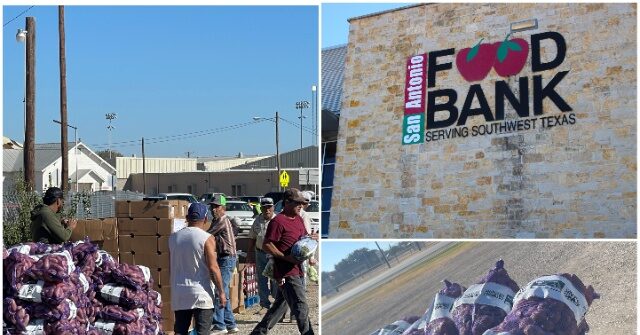“I hope this is going to be enough,” said the coordinator at Silver Lake Community Church food pantry, wiping her forehead as she chopped off bad ends of donated celery. Every Wednesday morning for the past year, I, along with a dozen or so other volunteers, sort and pack donated food for about 150 families.
But a few months ago, the food pantry started ordering enough food to feed 175 households a week. This week we ordered enough for 200 families. Higher numbers are our new normal. The people who come to us are facing challenges not just from the federal shutdown but also from widespread layoffs.
Now, as SNAP benefits run out during the shutdown, we worry that there won’t be enough food to feed everyone who lines up. And that should scare all of us.
Across the nation, 1 in 7 people — including 1 in 5 children — were food insecure in 2023. This means they worried about where they would get food and struggled to afford to put food on the table.
For decades, the U.S. government has responded to our relentless food insecurity crisis through the Supplemental Nutrition Assistance Program, formerly known as food stamps — which in 2024 were distributed to 1 in 8 people. On average, beneficiaries in California — where the program is called CalFresh — received about $189 a month. In L.A. County, more than $300 million in SNAP benefits were issued in June 2025 alone.
SNAP is an incredibly effective tool to fight hunger. It reaches people all over the nation, even in hard-to-reach rural areas, because the benefits go directly to people’s wallets. The program lifted more than 700,000 people nationally above the poverty line in 2024.
But SNAP alone has not closed the food insecurity gap. Its benefits only cover about 80% of the cost of food a family needs, and not everyone who qualifies participates in the program — nor is everyone who is food insecure eligible. It’s estimated that some 45% of food pantry users are already utilizing SNAP. Food pantries and soup kitchens — like the one where I volunteer — fill the gap by distributing donated and purchased food to people in need.
Nationwide, some 60,000 such organizations distributed more than 4 billion pounds of food to more than 50 million people in 2023. And even with the efforts of SNAP and charitable food programs, more than 40 million people are still food insecure.
With the disruption to SNAP funds, food pantries like my own will bear the brunt of responding to truly unprecedented need. Even as the state government deploys the National Guard to support food-distributing organizations such as the Los Angeles Regional Food Bank, my personal experience and research show that local organizations will struggle to take on the increased demand. Many pantries don’t have space to store more food nor the volunteers to sort and distribute additional food. Most have been operating at full capacity for years.
What’s worse is that pantries may simply run out of food. That means sending hungry people home empty-handed. To have to tell a neighbor you cannot help them is an experience I wish on no one.
But it isn’t only food-insecure people who benefit from SNAP. The program is a boon to local economies because people spend their SNAP dollars in the communities where they live and work. Even in a weak economy, the Agriculture Department estimates that $1 of SNAP generates more than $1.50 in economic activity. More than 30,000 stores in the state of California accept SNAP, which means that all communities benefit when people use food stamps.
Yet despite the billions of dollars they rely on from shoppers who use SNAP (many of whom are their own employees), large retailers such as Walmart and Amazon haven’t fought hard to prevent the current interruption to benefits. Retailers may be more concerned with preventing hungry people from shoplifting. The police department in Barstow posted on Oct. 28 that it would be stationing more police officers at grocery stores to deter theft.
A deep and lasting interruption to SNAP will kill people. And it will also hurt us all. Perhaps that’s the point. The Trump administration has been ordered to fund SNAP even during the government shutdown, but federal officials apparently see more value in wreaking havoc by issuing only partial payments — and doing so in slow motion. A people that is hungry doesn’t have the time or energy to fight back or vote or call representatives when basic human functioning is on the line.
The solution, broadly, is to fund SNAP. Some on the left fault the Trump administration as trying to “weaponize hunger,” in the words of the House’s top Democrat. Some on the right seek to blame Democrats for the shutdown. But no effort to score political points justifies making fellow Americans go hungry. Our politicians work for us. We should be calling our representatives and demanding that SNAP be taken off the bargaining table and that funding be permanently and fully reinstated.
The first Trump administration used its legal transfer authority during the last government shutdown to fund SNAP, and could do so again. This administration purposefully chooses not to.
In the meantime, those wanting to help can give money to local food pantries and feeding organizations. Although donations of food are well-intentioned and valuable, money stretches further in the hands of community organizations, which know what is needed — and it might be things like plastic gloves and paper bags required to safely get food into the hands of our neighbors. Organizations that sponsor holiday food drives might consider a fund drive instead or in addition.
Donations to local groups can be only a Band-Aid, not a permanent solution. Even SNAP, when fully funded, is not enough to meet food need in the U.S. — but it is a patch that gets closer than anything else ever has. When SNAP is underfunded and cut, it isn’t just the food insecure who suffer, but all of us.
Leah E. Gose is an assistant professor of sociology at USC.
The post Contributor: Interruption in SNAP benefit turns a chronic hunger problem into an acute crisis appeared first on Los Angeles Times.




